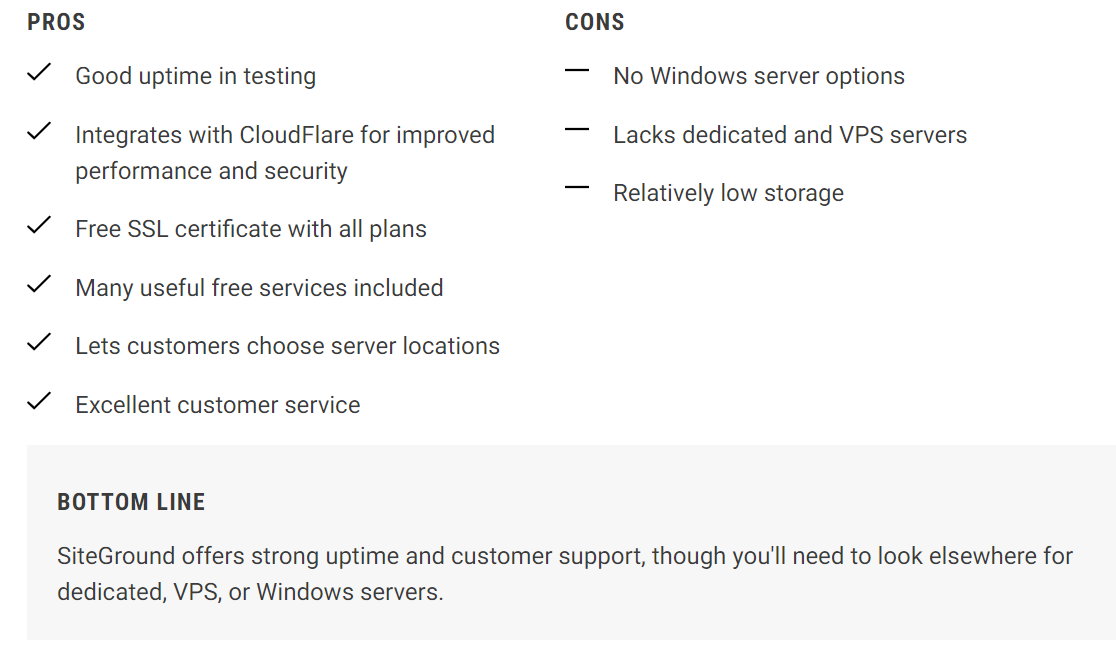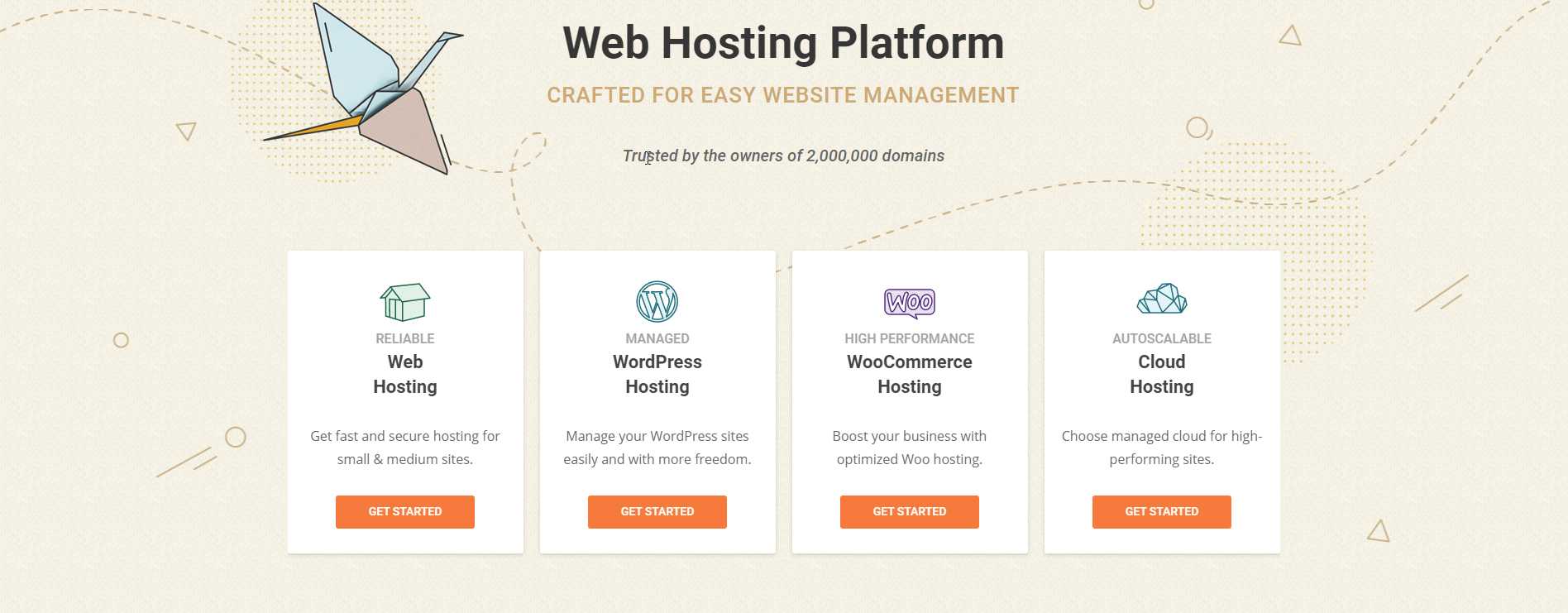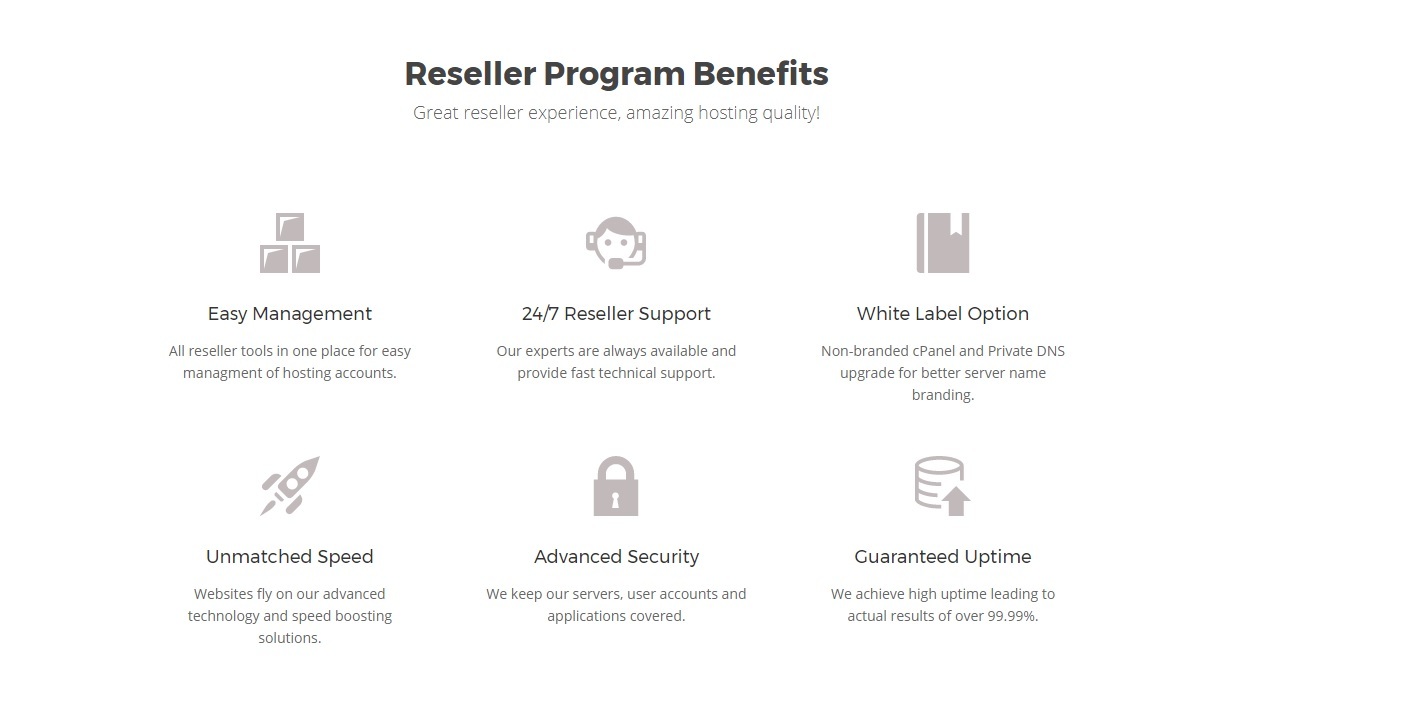
There are many variables to consider when you’re selecting a web hosting service. For example, there are features that appeal to a general customer base (such as pricing and storage), as well as features that are more business focused (such as e-commerce and server location). SiteGround addresses all of these issues, and does so well. It offers a decent number of hosting types, lots of performance-enhancing tools, and excellent customer service at a reasonable price. Although SiteGround lacks VPS, dedicated, and Windows servers, it’s a quality web hosting service for both individuals and small businesses.
Shared Web Hosting
If you’re interested in low-cost web hosting, shared hosting is the tier you want to investigate. With shared hosting, several websites bunk together on a single server, thus lowering the overall cost. That said, the multiple sites literally share the server’s computing power, which means your site’s performance could be negatively impacted if another bunk-mate has a huge traffic surge from a Reddit hit.
SiteGround, like a few other web hosts, lets you choose which data center you want to host your website: United States (Chicago), Europe (Amsterdam, Milan, Germany), Asia-Pacific (Singapore), United Kingdom (London), and Australia (Sydney). If you are concerned about data privacy or retention laws, you can choose a European data center. If many of your users are based in Asia, you can choose to use an Asia-Pacific data center. Or you can just default to a US server. I can’t imagine a lot of businesses will need this feature, but it’s a surprisingly advanced option for such a newbie-focused provider.
The StartUp plan (starting at $19.99 per month, with multi-month discounts) includes one website, 10GB of storage, network traffic suitable for roughly 10,000 visitors a month, a one-year free Secure Socket Layer (SSL) certificate, daily data backups, unlimited email, and support for CloudFlare (more on this later) and managed WordPress.
The GrowBig plan (starting at $29.99 per month, with multi-month discounts) builds upon the base plan. It has everything included in that tier, plus support for unlimited websites, unlimited databases, 20GB of storage, site staging, and network traffic suitable for approximately 25,000 visits a month.
The GoGeek plan (starting at an expensive $44.95 per month, with multi-month discounts) plan is intended for still-larger sites. It takes GrowBig to the next level by including 40GB of storage, network traffic “suitable” for approximately 100,000 visits a month, priority support, white-label support, and a Git repository.
Note that SiteGround says it can handle more visitors than the stated limits, but only as one-time occurrences (such as when your blog lands a Reddit hit) per month. I give props to SiteGround for its limitation transparency; most web hosts, even the ones that boast “unlimited” visitors and/or data, have some traffic restrictions buried in their terms of service.
SiteGround has solid shared hosting plans, but they aren’t as robust as HostGators’ offerings. The Editors’ Choice for shared web services matches SiteGround’s specs, plus has the option for users to select a Windows-based server (SiteGround only offers Linux-based shared servers). Companies that are deeply invested in Microsoft’s web ecosystem will find HostGator’s Windows servers attractive.

Cloud, not VPS
SiteGround no longer has VPS hosting, but boasts cloud hosting. The Linux-based platform, which draws resources from multiple servers, is designed to auto-scale with traffic surges, so that your site won’t go down due to a lack of power.
The four Cloud Hosting plans start at $80 per month for 4GB of RAM, 40GB of storage, and 5TB of monthly data transfers, and max out at $240 per month for 10GB of RAM, 120GB of storage, and 5TB of monthly data transfers. There’s lots of room for growth. You can also customize your Cloud Hosting plan should you need more power. They also include a free, one-year SSL certificate.
Still, DreamHost remains our co-Editors’ choice for cloud hosting service, along with the enterprise-friendly 1&1 Ionos . DreamHost’s Linux-or-Windows-based packages start at $4.50 per month (for 512MB of RAM, 100GB of storage, and unlimited monthly data transfers) and top out at $48 per month (for four CPU cores, 8GB of RAM, 100GB of storage, and unlimited monthly data transfers). Ionos, on the other hand, has prorated plans, custom hosting packages, and big specs for big businesses.
Note: If you’re in the hunt for traditional VPS hosting, check out Hostwinds, the category’s Editors’ Choice, which offers a fine virtual private server package.
No Dedicated Web Hosting
SiteGround also lacks a dedicated hosting tier. If you’re looking for take hosting type, we suggest taking a look at AccuWeb, PCMag’s Editors’ Choice for dedicated web hosting. It not only has a choice of Linux and Windows operating systems, but also tops out at 512GB of RAM, 2TB of storage, and 20TB of monthly data transfers.

WordPress Web Hosting
Like many of its competitors, SiteGround offers WordPress hosting. In fact, SiteGround oversees your installation with optimized managed WordPress hosting, a service that grants your website enhanced security, automated daily backups, page caching, staging, and automatic content management system updates. It also offers one-click installation and a free account transfer. SiteGround no longer offers a free domain name, but it offers substantial discounts for registration. The plans are similar to the company’s shared hosting plans in regards to price. Your options are to sign up for one-, two-, or three-year contracts.
SiteGround’s base WordPress tier, StartUp ($9.95 per month), offers a skimpy 10GB of storage, a mere 10,000 monthly visitors, and the ability to host just one WordPress site. GrowBig ($14.95 per month) ups the storage to 20GB and monthly visitors to 25,000, while letting you host unlimited WordPress sites. The top-level plan, GoGeek ($29.95 per month), builds upon GrowBig with its 30GB of storage and 100,000 monthly visitors. All plans come with unlimited email and monthly data transfers. SiteGround also offers numerous free WordPress themes. SiteGround includes many useful in-house tools for building your WordPress site: WP Migrator, SG Optimizer, and SuperCacher.
On the other hand, A2, the Linux-based PCMag Editors’ Choice for WordPress hosting, has no such visitor caps. Each of its plans, starting with the $7.99 per month Lite plan, includes unlimited storage and monthly data transfers. The top-tier Managed plan ($75.48 per month) adds site staging so you can experiment with site changes before they go live, unlimited websites, and unlimited databases.
That said, once you’re logged into SiteGround’s WordPress setup, you can create posts, pages, and galleries as you would with any other self-hosted WordPress site. If you want to set up a non-managed WordPress site, you can do that, too. I clicked on the WordPress icon in the advanced control panel to go to the WordPress page in Softaculous, SiteGround’s third-party application library. It launched a wizard that walked me through the installation. SiteGround also let me enable the Clef plug-in, which gives users the ability to log in to WordPress with their phones instead of a username and password. I am surprised and pleased to see these advanced features here.
Reseller Web Hosting
If you’re looking to get into the web hosting business, but you don’t want to deal with infrastructure matters, check out SiteGround’s three reseller hosting packages: GrowBig, GoGeek, and Cloud. GrowBig (starting at $29.99 per month, with multi-month discounts) offers 20GB of storage, unlimited websites, unlimited databases, site staging, and WP-CLI and SSH. GoGeek (starting at $44.99 per month, with multi-month discounts) builds up things with 40GB of storage, priority support, and white-label client support. Cloud (starting at $80 per month, with multi-month discounts) has “40GB+” storage, and the ability to tailor sites’ resources and customize clients’ access.
Hostwinds goes the extra mile with more generous specs in a variety of server categories. As a result, Hostwinds is the Editors’ Choice for reseller hosting.
Setting Up a Website
SiteGround leverages Weebly as its website builder of choice. It’s a good move, as Weebly let me make attractive web pages without sacrificing much of my time. Weebly made it simple to add text, images, and video to my test pages. For more information on this simple site builder, please read our Weebly review.
E-Commerce and SSL
Instead of using Weebly, I could have also set up my site from the get-go with e-commerce software, such as PrestaShop, CS-Cart, or Magento. The control panel has the icons for these platforms under AutoInstallers, making them easy to find. You can also go to Softaculous and pick one of the 30 available options, including Zen Cart, ShoWare, OpenCart, and Axis, to name a few.
I used Magento to create an attractive store using its drag-and-drop store builder. If you only need a shopping cart, that’s no problem, or if you want to focus only on invoicing and billing, there is an app for that, too.
If you plan to sell products online, you’ll want a secure socket-layer (SSL) certificate. The web host includes them for free in all plans above the shared StartUp tier. Siteground also offers Wildcard, a premium SSL certificate that secures your top-level domain, as well as an unlimited number of subdomains. Wildcard is bundled as a free, one-year bonus feature when you sign up for the GrowBig or GoGeek packages. Otherwise, it’s $60 per year.
Security Features
SiteGround offers several security options, including the SG Site Scanner to let you know if your site is under attack, antispam tools SpamAssassin and SpamExperts, hotlink protection, and IP address blocklists. It scans all the links on your homepage to make sure that they’re clean.
SiteGround also offers an interesting feature called Leech Protect, which lets administrators prevent users from giving out or publicly posting their passwords to portions of the site. I also like the fact SiteGround integrates with the CloudFlare content delivery network (CDN) service for better performance and security. While any site owner can easily sign up with CloudFlare, the integration (available for free!) means more people who had no idea this was an option are now able to benefit.
Another helpful tool is SiteCheck. This automatic software scanning tool checks your website to see if there is any malware in the code or on the site. Running it periodically is a good idea, since the last thing you want to see in your email inbox are messages from irate users saying that visiting your website infected their computers. SiteGround also has free daily backups to safeguard your data.
Solid Uptime
Website uptime is one of the most important aspects of a hosting service. If your site is down, clients or customers will be unable to find you or access your products or services.
For this testing, I use a website monitoring tool to track my test sites’ uptime over a two-week period. Every 15 minutes, the tool pings my website and sends me an alert if it is unable to contact the site for at least one minute. The data revealed that SiteGround is stable; our test site went down once for a few minutes during the two-week observation period. Though we obviously prefer sites to not go down at all during our tests, SiteGround’s downtime wasn’t too atrocious.
Customer Service
SiteGround says its main focus is on customer service, and it shows in the service’s many wizards, knowledgebase articles, and tutorials. Customer support is available through a ticket-based system, live chat, and 24/7 telephone support.
I tested SiteGround’s online chat and am amazed at how quickly someone came to my aid. I was connected to a chat representative in a few seconds. I asked about the differences between SiteGround’s cloud hosting and dedicated hosting, and received a prompt and clear response.
I also called the phone number on a weekday morning to ask a representative about how to import my WordPress.com setup into SiteGround. The representative patiently and successfully walked me through the process.
SiteGround lets users cancel within 30 days of when their credit card was charged. It’s tolerable, but I prefer DreamHost’s lengthy, 97-day money-back guarantee.
For Beginners, Businesses, and Beginner Businesses
SiteGround is clearly positioning itself as a hosting provider for newbies, and especially small business newbies. SiteGround’s services—from its features to support resources—are designed for the mom-and-pop stores, sole proprietors, and independent businesses that don’t have a lot of design time or advanced web skills. Furthermore, if you aren’t expecting a flood of users to your site each day, you don’t really care about unlimited storage or unlimited monthly data transfers, so SiteGround’s limitations in those regards might not bother you.
Additionally, SiteGround’s surprising number of security features also indicates that it has small businesses in mind. Small businesses are highly vulnerable to website attacks, and chances are they are not going to invest in a site scanner to look for malware or a cloud provider to protect them from a denial-of-service attack. The fact that SiteGround does it for them makes it a solid friend for small businesses just starting out. Still, if you need greater storage and bandwidth allotments, consider moving to Editors’ Choices Dreamhost, HostGator, Hostwinds, or Liquid Web for more advanced features and beefed-up storage.
For more on getting started online, read our tips on how to create a website. You might also want to check out our story on how to register a domain name for your website.


0 Comments